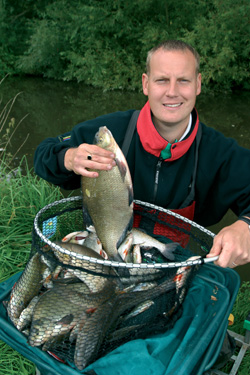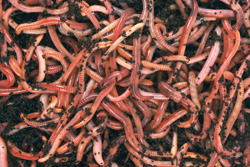Paul Boothby’s Top 10 Tips For Worms
Always use fresh bait. Freshly turned casters and worms that have been kept cool are far better fish attractors than older bait.
Always work your bait by lifting and dropping the rig. You can also try dragging the worms about the swim to induce bites.
Always chop some of the worm feed very finely to create a lot of attractors in the water around it.
When the water really cools down feed some chopped lobworms to hold better fish in the peg.
Use a round-bend hook that holds the worm on well. You need to leave plenty of hook point showing to hit fast bites.
Loose feed casters over the top of the main feed to help attract and hold more fish in the swim.
Use a worm’s tail when you want a very active bait but never ignore the head section.
Because you’re looking to target better fish with worms don’t scale your tackle down too much.
Find a decent depth to fish in. A depth of two to three feet is perfect as you’ll be able to hold better fish there.
Make sure you choose the right size worms for the species you’re targeting. You can’t go far wrong with dendrabaena worms most of the time.
 |
| A great bag of Shropshire Union Canal fish on the deadly dendra! |
Types of worm
The four main types of worms used in the UK for fishing are dendrabaena, redworms, lobworms and brandlings, which are now not as popular as they used to be. These four types of worms, contrary to popular belief, are all native to the UK. Lobworms are the most natural of all as they’re found near rivers and are usually washed into the water off nearby land when there’s a heavy rainfall.
Redworms are actually the softest of all worms available, which is probably what makes them so appealing to skimmers and bream in particular. Dendrabaena worms are the toughest of all because in places where they are native to the UK, they live under leaves in large forest areas, so have to be able to cope with rapid changes in temperature.
The yellow fluid a worm sometimes excretes from the head is actually caused by the worm being stressed and fish don’t like it at all. To avoid your worms becoming stressed, they need to be fed properly with cold, cooked mashed potato, brown crumb and peat, all mixed together into a paste-type consistency. Also, worms have to be stored at a constant temperature and the best is 2°C. The matter they’re stored in needs to have a pH level of 6.5.
Worms also like citrus fruit and banana is another good feed. You’ll know when what you’re feeding them is wrong because they’ll actually develop red skins, which is actually burnt from the food.
It takes a worm 16 weeks to grow from half an inch to a few inches providing it’s kept at the correct temperature and has a good food supply.
Dendrabaena worms are the most popular in the country simply because they’re tough. They can withstand being shipped long distances and they’re in good supply – fish love them. However, many top worm anglers believe lobs are the top bait as they’re the most natural of all, if a bit more expensive.
Many anglers also try to breed their own worms. However, they simply will not reproduce in a confined area as they lay the worm eggs, then leave the area so that there’s enough food left for the baby worm hatch.
Often, you’ll also find worms will huddle up in one spot in a container and that’s where they’re happiest, where there’s enough food and where the temperature is right for them.
A dendrabaena worm, unchopped, will last in water for around 14 hours and because all their organs are within the top third of their body, you can actually chop the tail off and it’ll re-grow a new part, albeit stunted.






